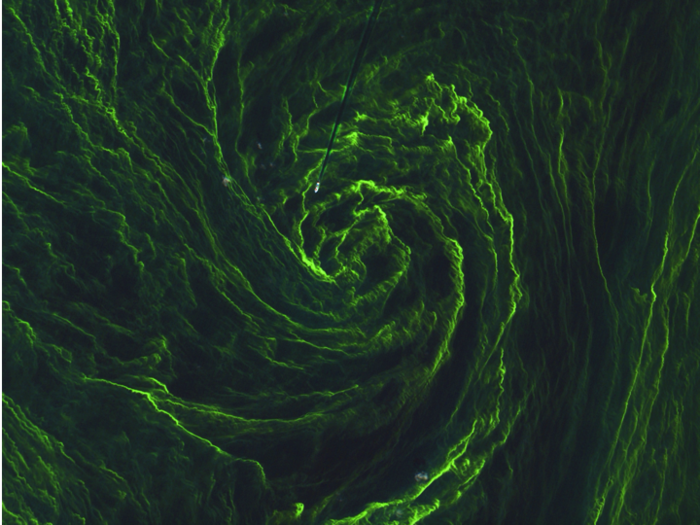Source: European Space Agency
The Sentinel-2A satellite has been in orbit for only a matter of weeks, but new images of an algal bloom in the Baltic Sea show that it is already exceeding expectations. Built essentially as a land monitoring mission, Sentinel-2 will also certainly find its way into marine applications.
Warm weather and calm seas this August have increased the amount of biological activity in the central Baltic Sea, with the Finnish algae monitoring service Alg@line reporting a dominance of cyanobacteria in the region at this time.
The Baltic Sea faces many serious challenges, including toxic pollutants, deep-water oxygen deficiencies, and toxic blooms of cyanobacteria affecting the ecosystem, aquaculture and tourism.
The situation was so bad that in 1974 the Helsinki Convention for the Protection of the Marine Environment of the Baltic Sea Area was created to improve the state of the sea. Since then, the health of the Baltic Sea has improved dramatically.

Eye of an algal storm
Sentinel-2A was launched on 23 June, primarily to monitor land and vegetation for Europe’s environmental monitoring Copernicus programme. This new satellite carries a high-resolution instrument that covers 13 spectral bands with a swath width of 290 km.
This instrument is already exceeding expectations when it comes to monitoring the biology of coastal waters, as seen in these spectacular images of the central Baltic Sea taken on 7 August. The images, showing detail down to 10 m across, reveal exquisite detail of an algal bloom.
Blooms in the Baltic Sea usually appear as a green–yellow soup or a mass of blue–green threads along density gradients within the sea. The streaks and filaments, eddies and whirls of biological activity are clearly visible in these new images.
Cyanobacteria have qualities similar to algae and thrive on phosphorus in the water. High water temperature and sunny, calm weather often lead to particularly large blooms that pose problems to the ecosystem and, therefore, aquaculture and tourism. Toxicity varies between different species, but can also vary within the same species. Because of this, several teams monitor the status of blooms in the region using ships.
Sentinel-2A’s resolution of 10 m in multiple bands allows Copernicus services to monitor biological activity in the region. While it was optimised for land applications, it is clearly a valuable tool for monitoring ocean colour. A ship can even be seen in the top image heading into the ‘eye’ of this algal storm. The ship’s track is visible as straight dark feature where the algae have been disturbed by turbulence created by the ship’s propellers as it mixes water in its wake.

